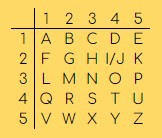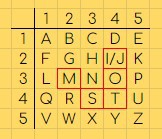
Who’s This Square?
Old mate Polybius was a Greek born about 200BC, but the method he made famous has influenced more sophisticated systems to this day. Originally, old mate Polybius had intended this code to be used in conveying messages long distance by moving a flaming torch up and down in sequence, with the message passed from tower to distant tower.
Squaring Things Up
First we need a little table of our alphabet. This cipher typically combines the letters ‘i’ and ‘j’ in one cell.

Each letter of the alphabet has its own grid reference. ‘A’ is 11, ‘B’ is 12, and so on.
Using everyone’s favourite word ‘moist’ as an example, we find the reference for each of the letters: 32 – 34 – 24 – 43 – 44

32=M, 34=O, 24=I, 43=S, 44=T. Done.
What you do with the numbers from here, to further hide your code, is up to you.
Getting The Word Out
Let’s say you have been given a long number or sequence, delivered in the classic block of five characters.
42342
From here we can split it up into pairs, and find that the 9 at the end is just filler.
42 34 22 15 42 14 11 31 44 42 15 54 9
Find the grid reference for each of these combinations to find who we are talking about.
Knock Knock- …
The simple numerical nature of this encoding technique means that it can be communicated by sound too.
Forget your dits and dahs, you don’t need them any morse. Sorry, any more.
Using our basic Square setup, we could ‘knock’ the following to determine who is there:

Straight To Other Tables
This “tabula recta” can be filled out however you like. Mix up your alphabet to make it trickier, use a different alphabet altogether (Cyrillic or Hiragana), throw in your own symbols (or numbers to save time), or do all of the above and expand it beyond 5×5 cells.
Square Rooms
Where will you find this in your Escape Room? They will always provide the table as a key for deciphering, so hold on to the seemingly random sequence of numbers you have found. Repetitions of lower numbers are important (notice how our ‘9’ in the example above was just filler at the end).
Or, if you find the table first, start looking for an even-numbered sequence, but be aware, your crafty designers may have put an extra level of puzzling before you can use it to find your references.
22343414314513251543131135243322!!!

